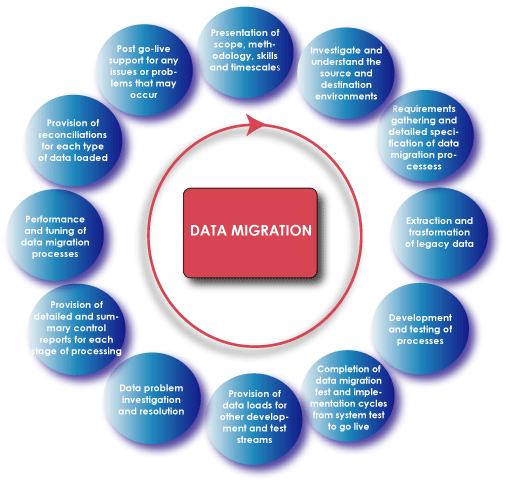Data Migration
What Is Data Migration?
Data migration is the process of transferring data between storage types, formats, or computer systems. It is a key consideration for any system implementation, upgrade, or consolidation. Data migration is usually performed programmatically to achieve an automated migration, freeing up human resources from tedious tasks. Data migration occurs for a variety of reasons, including server or storage equipment replacements, maintenance or upgrades, application migration, website consolidation and data center relocation.
Factors to consider in a data migration project include :
How long the migration will take?
The amount of downtime required?
The risk to the business from technical compatibility issues, data corruption, application performance issues, and missed data or data loss.

Categories:
Data is stored on various media in files or databases, and is generated and consumed by software applications which in turn support business processes. The need to transfer and convert data can be driven by multiple business requirements and the approach taken to the migration depends on those requirements.
1.Storage Migration
A business may choose to rationalize the physical media to take advantage of more efficient storage technologies. This will result in having to move physical blocks of data from one tape or disk to another, often using virtualization techniques. The data format and content itself will not usually be changed in the process and can normally be achieved with minimal or no impact to the layers above.
2.Database Migration
It may be necessary to move from one database vendor to another, or to upgrade the version of database software being used. The latter case is less likely to require a physical data migration, but this can happen with major upgrades. In these cases a physical transformation process may be required since the underlying data format can change significantly.
3.Application Migration
Changing application vendor – for instance a new CRM or ERP platform – will inevitably involve substantial transformation as almost every application or suite operates on its own specific data model and also interacts with other applications and systems within the enterprise application integration environment. Furthermore, to allow the application to be sold to the widest possible market, commercial off-the-shelf packages are generally configured for each customer using metadata. Application programming interfaces (APIs) may be supplied by vendors to protect the integrity of the data they have to handle.
4.Business Process Migration
Business processes operate through a combination of human and application systems actions, often orchestrated by business process management tools. When these change they can require the movement of data from one store, database or application to another to reflect the changes to the organization and information about customers, products and operations. Examples of such migration drivers are mergers and acquisitions, business optimization and reorganization to attack new markets or respond to competitive threat.
The first two categories of migration are usually routine operational activities that the IT department takes care of without the involvement of the rest of the business. The last two categories directly affect the operational users of processes and applications, are necessarily complex, and delivering them without significant business downtime can be challenging. A highly adaptive approach, concurrent synchronization, a business-oriented audit capability and clear visibility of the migration for stakeholders are likely to be key requirements in such migrations.